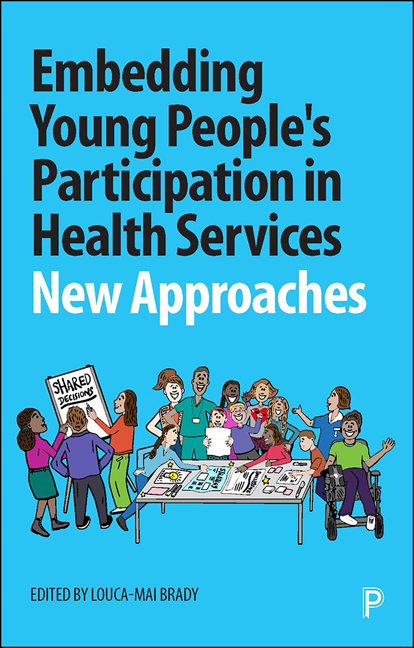Book contents
- Frontmatter
- Dedication
- Contents
- List of Boxes, Figures and Tables
- Summary
- Notes on Contributors
- Acknowledgements
- Foreword
- Introduction: Embedding Young People’s Participation in Healthcare
- PART I Young People’s Participation in Individual Decision-Making
- PART II Participation in National Projects and Programmes
- PART III Collaborative Research in NHS Services
- PART IV Young People-led Participation
- Index
8 - Investing in Children: Respecting Rights and Promoting Agency
Published online by Cambridge University Press: 25 February 2021
- Frontmatter
- Dedication
- Contents
- List of Boxes, Figures and Tables
- Summary
- Notes on Contributors
- Acknowledgements
- Foreword
- Introduction: Embedding Young People’s Participation in Healthcare
- PART I Young People’s Participation in Individual Decision-Making
- PART II Participation in National Projects and Programmes
- PART III Collaborative Research in NHS Services
- PART IV Young People-led Participation
- Index
Summary
Introduction
Investing in Children (IiC) is an organisation which exists to promote the human rights of children and young people, in particular their right to have a say in decisions that affect them, as defined by Article 12 of the United Nations Convention on the Rights of the Child (UNCRC). We do this primarily by creating spaces in which children and young people can come together, identify and discuss issues, and develop arguments about how these issues might be addressed. IiC then supports them to enter into dialogue with adults who have the power to act on their agenda.
This chapter will draw upon IiC's archive of work over the last 22 years, along with testimony from young people involved in two of our current projects: Type 1 Kidz, an initiative for young people with Type 1 diabetes, and YASC, a youth café providing support to young people transitioning from CAMHS (Child and Adolescent Mental Health Services) to Adult Mental Health Services, to inform a discussion on the nature of effective engagement in dialogue, and the relevance and significance of IiC's collaborative approach. In particular, we will consider the notion that participation is not a single event (or a series of events) but a sustainable process through which children and young people are seeking to take effective action on issues which they identify as in need of change. It is this clarity about the purpose of participation which lies at the heart of the IiC approach.
In Section 2 we consider some of the complexities of creating opportunities for children and young people to be seen as genuine contributors to dialogue about decisions that affect them, and how focus on the process of participation without critical attention on the purpose and intended outcomes of participative practice has resulted in confusion.
In Section 3 we describe the origins of IiC, and how the IiC practice model developed, highlighting a key point at which the contribution of children and young people changed the direction of the organisation by helping us to appreciate the difference between consultation and active participation. In Section 4 we consider three case examples, one from our archive and two from our current range of projects, where the participants have gone on to become active agents in creating new solutions to the dilemmas that they faced.
- Type
- Chapter
- Information
- Embedding Young People's Participation in Health ServicesNew Approaches, pp. 205 - 230Publisher: Bristol University PressPrint publication year: 2020



